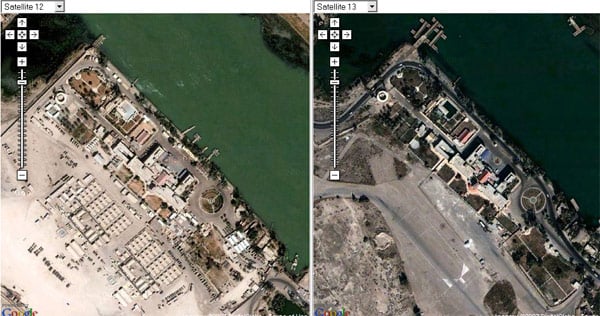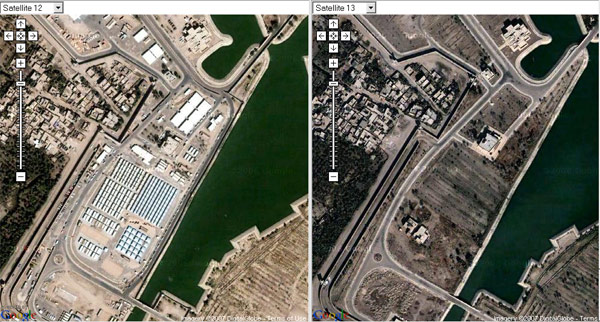Original URL: https://www.theregister.com/2007/01/17/google_erases_brit_bases/
Google erases British bases in Iraq
Terrorists planned attacks using Google Earth, Army says
Posted in Legal, 17th January 2007 14:05 GMT
It appears Google has replaced recent satellite imagery of British military bases in Basra with pre-war snaps following Army claims that terrorists were using Google Earth to plan attacks on its facilities.
According to a recent report in the Telegraph, "documents seized during raids on the homes of insurgents last week uncovered print-outs from photographs taken from Google". The images showed in detail "the buildings inside the bases and vulnerable areas such as tented accommodation, lavatory blocks, and where lightly armoured Land Rovers are parked".
On the back of one set of images showing the Shatt al Arab hotel - home to 1,000 men of the Staffordshire Regiment battle group - insurgents had written the "precise longitude and latitude".
An intelligence officer with the Royal Green Jackets battle group said: "This is evidence as far as we are concerned for planning terrorist attacks. Who would otherwise have Google Earth imagery of one of our bases?
"We are concerned that they use them to plan attacks. We have never had proof that they have deliberately targeted any area of the camp using these images but presumably they are of great use to them.
"We believe they use Google Earth to identify the most vulnerable areas, such as tents."
The Army's Basra bases "experience mortar and rocket attacks on a daily basis", the Telegraph notes. The paper continues: "Since the maps were found intelligence chiefs have been keeping track of where rounds land to see if the insurgents are using them to pinpoint weakly protected areas."
Major Charlie Burbridge, the British military spokesman in Iraq, said: "We take the security of our bases very seriously and we constantly review the means to provide secure accommodation for our soldiers. There is a constant threat of reconnaissance missions to access our bases and using these internet images is just another method of how this is conducted."
Google's response to the revelation was to note the information could be used for "good and bad" and is "available to the public in many forms". Regarding reported Army advances to have the offending images removed, a spokesman noted: "Of course we are always ready to listen to governments' requests. We have opened channels with the military in Iraq but we are not prepared to discuss what we have discussed with them. But we do listen and we are sensitive to requests."
It appears the search monolith has indeed shown its sensitive side, since the current Google Earth images of Basra show no sign of the British Army presence (try these .kmz links to the Shatt al Arab camp and Basra Palace complex).
This, sadly, may prove inadequate in the face of the determined terrorist. The Google Earth community was quick to spot the apparent update, with Ogle Earth noting: "Currently, images in Google Earth of Basra are from 2002, months before war. Up until a recent update, the images were likely from late 2004 and/or 2005."
The proof comes from a handy comparison tool which offers "before and after" views by comparing current and older Google satellite imagery of the same area. Here's the Shatt al Arab camp seen in all its previously exposed glory on the left, and in the pre-war state now showing on Google Earth on the right (click on pic for a bigger view):
And here's a detail of Saddam's former riverside Basra Palace complex:
While it's evident the Army had a legitimate cause for complaint, the fact that the offending hi-res images are still available online, coupled with the Telegraph's revelation that print outs of the bases "are being sold to rogue militias in the market place in Basra", suggest Google's actions may have come too late.
Which will do little to calm tempers among some Army units. Soldiers from the Royal Green Jackets based at the Basra Palace base told the Telegraph "they had considered suing Google Earth if they were injured by mortar rounds that had been directed on the camp by the aerial footage".
One soldier pointed out: "Even if they did blank out the areas where we are based it is a bit after the horse has bolted as the terrorists now have the maps and know exactly where we eat, sleep, and go to the toilet." ®

